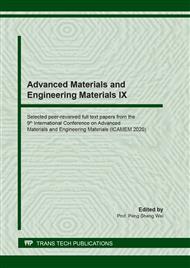p.259
p.264
p.270
p.277
p.284
p.289
p.295
p.303
p.309
Mn3O4 Nanosheets Decorated on Graphene Modified Carbon Cloth with Improved Pseudocapacitive Performance
Abstract:
Mn3O4 nanosheets were deposited electrochemically on graphene modified carbon cloth (G–CC). The graphene layer improved significantly the hydrophilic property of carbon cloth and its compatibility with active materials, as a result, lower resistance and better structural stability were obtained for Mn3O4/G–CC compared with those for the electrode based on neat carbon cloth. Furthermore, the Mn3O4/G–CC possessed a capacitance of 1335 mF cm–2 at a current density of 2 mA cm−2, and a capacitance retention of up to 88 % after 2000 cycles at 10 mA cm–2. It is believed that manganese oxide was anchored strongly on graphene layer through C–O–metal bonds, and the graphene layer on the surface of the CC could serve as elastic buffering layers to release the strain within manganese oxide, resulting the remarkable improvements in electrochemical performance. These excellent characteristics make this kind of the composites promising candidates as high performance electrodes for supercapacitor.
Info:
Periodical:
Pages:
284-288
Citation:
Online since:
September 2020
Authors:
Price:
Сopyright:
© 2020 Trans Tech Publications Ltd. All Rights Reserved
Share:
Citation:


